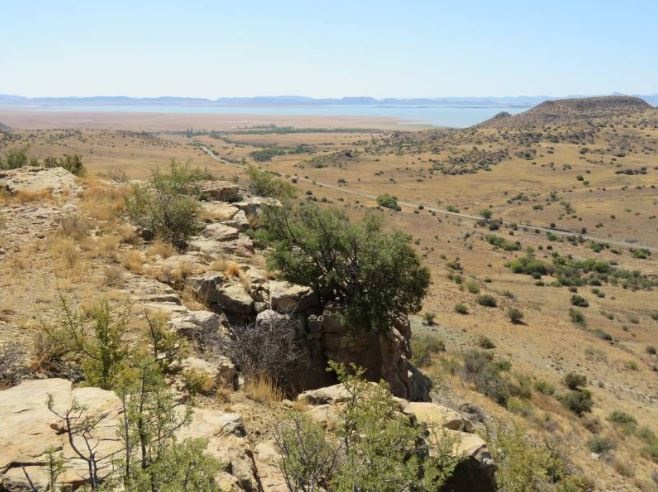For most people, the Karoo is a picturesque part of South Africa made famous by its tasty lamb and its game reserves. But to the palaeontologists, the researchers who study extinct species, the Karoo represents a gigantic playground packed with millions of fossils that recorded the evolution of life between 270 to 200 million years ago, from the origin of turtles and mammalian ancestors, to the diversification of early dinosaurs.
This is why, as a lecturer and palaeontologist at the Evolutionary Studies Institute of the University of the Witwatersrand, it is important to me to introduce our students to the most exciting part of our job: fieldwork in the Karoo.
In collaboration with the Eastern Cape Parks and Tourism Agency and Eastern Cape Provincial Heritage Resources Authority, my colleagues and I conducted during last November a field trip with 12 of our students (honours, masters, and PhDs) to the Oviston Nature Reserve, in the Eastern Cape, on the scenic shoreline of the Gariep dam. This place was already known for yielding fossils since the 1970s. Little did we know what amazing discoveries we would make there!
The place was covered with fossil bones. Two-hundred-and-fifty million years old skeletons of an herbivore called Lystrosaurus were lying on the ground, undeformed and well preserved, like if they just died here a couple of days ago.
Every student had the opportunity to find one, a true treasure trove of ancient bones! Even the rangers, some of them who did not know what fossil bones looked like the very same morning, started finding skulls and skeletons of Lystrosaurus. The students and the rangers were working together, the latter engaging with the former about what they were finding and what were the implications of it.
Enthusiasm was bathing the place. There is nothing like calling the students for a break and realize that they cannot stop looking for fossils because they are so excited about what they are finding. I live for these moments.
According to previously published palaeontological and geological accounts, the Oviston Nature Reserve would be located on an important geological contact between the sediments of the Permian and Triassic periods.
This boundary between the Permian and Triassic is famous globally as it recorded the Permian-Triassic mass extinction, or "Great Dying", the most catastrophic event of mass extinction that ever happen on Earth. 90% of all living things became extinct, which makes it nothing less than the most important and significant event of the history of life on Earth.
One of the only surviving species was Lystrosaurus. Large species of Lystrosaurus that lived in the Permian evolved into smaller species at the onset of the mass extinction, which enabled them to reproduce faster. Their burrowing lifestyle might also have helped them to survive.
Fascinatingly, we found both large and small Lystrosaurus specimens at the Oviston Nature Reserve, supporting the hypothesis that a Permian Triassic boundary is indeed recorded here. The flat landscape delivered large Lystrosaurus fossils, whereas the ones found uphill were distinctly smaller. This suggests that the mass extinction event is recorded somewhere in between these two strata and calls for further research to find exactly where.
Complete sections recording the Permian-Triassic extinctions are very rare and finding more of them may shed some fresh light on this catastrophic event.
If the Oviston Nature Reserve proves to house an uninterrupted Permian to Triassic sequence, it would mean that a complete record of the most important event in life history is preserved there. This makes it a site of global scientific relevance, similar to the Bethulie site located nearby.
Even more striking was the fact that we discovered not one, but three skulls of the rare cynodonts, the ancestors of mammals. Cynodonts were small carnivorous and insectivorous animals, not unlike mongooses overall. They belong to the same family as Lystrosaurus, called the Therapsids, but while the Lystrosaurus side of the family tree eventually ended up in a dead-end, the cynodont branch carried on and survived to give birth to modern mammals, including our own ancestors the Primates. The future study of these new cynodonts may change the way we understand mammalian origins today, but more importantly, they will be the opportunity for our students to work and conduct proper research on fossils that they found themselves, which is priceless.
In addition, the fossils at the Oviston Nature Reserve are so conspicuous and visually appealing that literally anyone can see them and realize that they belong to a long-gone animal. This is why we are now closely collaborating with the Eastern Cape Parks and Tourism Agency and Eastern Cape Provincial Heritage Resources Authority in order to develop palaeotourism in the area by creating a new fossil park. Some well-preserved fossils were left in place in the rock for everyone to see and witness the miraculous preservation of these hundreds of million years old bones.
Much work has to be done at the Oviston Nature Reserve and in the Eastern Cape to fully grasp all the implications of what the students and rangers discovered on this fateful days. What started as an educational field trip to show students how to look for fossils so rapidly turned into a highly scientifically relevant hunt for fossils that it can only hold great promises for the future.
- Julien Benoit is a senior researcher at the University of the Witwatersrand focusing on Paleobiology, Neuroscience and Evolutionary Biology.




 Publications
Publications
 Partners
Partners









